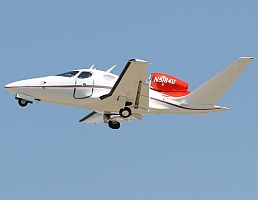 A postdoc and colleagues at Massachusetts Institute of Technology are developing an algorithm for a tracking system to predict and prevent collisions between small aircraft. The MIT team will present early results of its research in October at the 30th Digital Avionics Systems Conference in Seattle.
A postdoc and colleagues at Massachusetts Institute of Technology are developing an algorithm for a tracking system to predict and prevent collisions between small aircraft. The MIT team will present early results of its research in October at the 30th Digital Avionics Systems Conference in Seattle.
The Federal Aviation Administration (FAA) has mandated that by 2020, all commercial aircraft, as well as small aircraft flying near most airports, be equipped with a new tracking system that broadcasts GPS data. Current systems are built for ground-based radar, but GPS is believed to be more accurate in determining locations. General aviation should benefit from this system; in the past 10 years, 112 small planes have been involved in midair collisions, and thousands more have reported close calls.
FAA asked MIT to head a study of GPS’s limits and capacities. Maxime Gariel, a postdoc in MIT’s International Center for Air Transportation and lead author on the paper, says a key objective in this research is limiting false alarms. Too many false alarms will only encourage pilots to turn off or ignore the system.
Yet the system also needs a margin for error. GPS may be more accurate in providing a plane’s location but it is not perfect. In addition, errors can occur as a result of the communications channels, as well as unexpected changes in the plane’s direction.
Gariel addressed these issues first with establishing two types of warnings. In Gariel’s system, a moderate alert would warn pilots that their trajectories are converging, and a high alert would indicate a severe risk of collision.
For each type of alert, the algorithm determines a volume of space around each plane based on the aircraft’s GPS position. That volume of space is shaped like a flattened cylinder, resembling a hockey puck, giving more space for horizontal movement, which is easier for an aircraft than vertical movement.
The cylinder safety space for a moderate alert is larger and can fluctuate depending on the trajectories of aircraft. Planes traveling in the same direction will have smaller cylinder spaces. If the aircraft are headed to each other, however, the cylinder spaces become much larger.
If an extrapolation of the planes’ trajectories suggest a potential collision, the system would emit a moderate warning. The safety cylinder spaces for high alerts are smaller and fixed in size, and any intersection of those spaces would trigger a high alert.
To calculate the optimal cylinder space sizes, Gariel used six months’ worth of data from airports in the San Francisco area. To test the algorithm, the team took advantage of an accurate computer model of air traffic created at the MIT Lincoln Laboratory — a federally funded R&D center — based on more than eight months of data from all the aviation radar systems in the U.S. Gariel and colleagues tested their algorithm against the Lincoln Lab model and found that it had a low false-alarm rate.
The algorithm is still a work in progress. David Gray, FAA’s lead on the project, notes that the Lincoln Lab air-traffic model is based on radar data, and that small planes often fly below radar, particularly near airports, where nearly 60 percent of midair collisions take place. Gariel and grad student Fabrice Kunzi are working on a new computer model that takes into account the standard flight paths taken by small aircraft near airports, to see if the collision-detection algorithm still performs.
Photo: D. Miller/Flickr
* * *

 RSS - Posts
RSS - Posts
[…] Read more: Algorithm Being Developed to Limit Small Airplane Collisions […]
[…] Read more: Algorithm Being Developed to Limit Small Airplane Collisions […]